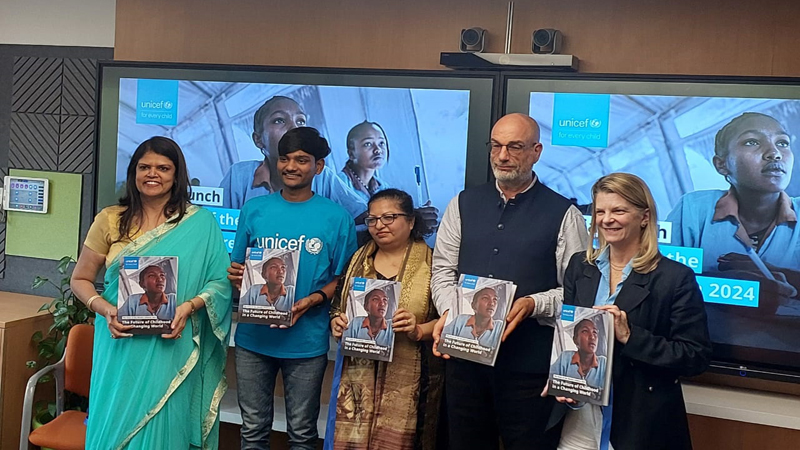UNICEF report highlights global megatrends influencing children’s future

New Delhi : UNICEF’S global flagship report, The State of the World’s Children 2024 report titled, ‘The Future of Children in a Changing World, was released here today by Cynthia McCaffrey, UNICEF India Representative together with Suruchi Bhadwal, Director, Earth Sciences and Climate Change program-The Energy Research Institute (TERI), two children and Kartik Verma, UNICEF India youth advocate.
The report looks ahead to 2050 and examines three global megatrends-demographic shifts, climate and environmental crises, and frontier technologies-that are anticipated to fundamentally reshape children’s lives, rights, and opportunities between now and mid-century.
Reflecting on the projections in the report, Cynthia McCaffrey said, “The three megatrends highlighted by the State of the World’s Children report compel us to examine how to support countries in creating a future that advances the rights of every child. Decisions made today will shape the world our children inherit in 2050. Collectively, we have the opportunity and responsibility to build a prosperous and sustainable future for all children. Placing children and their rights at the centre, in all strategies, policies and actions is the way forward.”
The report projects that by 2050, global child population will stabilize around 2.3 billion, with significant shift in regional distributions. India, China, Nigeria and Pakistan are expected to account for more than a third of the world’s child population by 2050. India will have approximately 350 million children, despite a decline of 106 million compared to today. Investment in education, healthcare, child benefits and skill development for children and young people are critical to address the challenges.
At the same time nearly 1 billion children already live in countries at high risk of climate hazards and this figure is expected to rise dramatically without significant interventions. Children are highly vulnerable to the climate and environmental crises, especially those who live in rural and low-income communities, with an anticipated eightfold increase in exposure to extreme heatwaves and significant risks from floods, wildfires, and cyclones. These climate-induced challenges worsen vulnerabilities impacting their health, education, and access to safe water. According to Children’s Climate Risk Index (CCRI), in 2021, India ranked 26th out of 163 ranked countries globally, with children particularly exposed to risks such as extreme heat, floods, droughts and air pollution.
Launch of the State of the World’s Children 2024
Suruchi Bhadwal, Director, Earth Sciences and Climate Change prog, The Energy Research Institute (TERI) said, “Climate change affects children differentially through both direct and indirect impacts on health making them vulnerable to the impacts of climate change. There is a strong need to have children join in the fight against climate change. Children can contribute immensely to the climate agenda by being active agents of change.”
Frontier Technologies like Artificial Intelligence offer both promise and peril for children, who are already interacting with AI embedded in apps, toys, virtual assistants, games, and learning software. But the digital divide remains stark. In 2024, over 95 per cent of people in high-income countries are connected to the internet, compared to nearly 26 per cent in low-income countries.
The impact of these megatrends on children will be determined by government investments in child survival and life expectancy; socioeconomic development; education; gender equality; conflict; urbanization; and the environment.
“The findings from the report are particularly important for India as it is projected that the country will be home to 15 percent of the global child population. It is critical for India to plan for the future so that children can achieve their full potential.
“India has made significant progress towards children’s rights. To continue on this path, we need to meet the challenges through continued child centric investments in health, quality education, skilling and job opportunities, bridging the digital divide for equal access to technology. In the coming decades, with almost half of India’s population projected to live in urban areas, investments in sustainable, child-friendly urban infrastructure will be needed.
“In all of this, importantly we need to hear from children and young people themselves, about the challenges they face, so that the future we build is sustainable, equitable and peaceful.
“UNICEF, over 75 years continues to partner with India, supporting children to have equal access and opportunities in realizing their ambition, where young Indians are empowered to lead India to its second century,” said Cynthia McCaffrey, UNICEF India Representative.
Kartik Verma, shared insights from his recent participation at COP29 as a UNICEF India Youth Advocate, “Climate change is a child rights crisis – it is affecting our health, education, and overall well-being. At COP29, I witnessed young people from across the world presenting innovative solutions and demanding urgent action. Climate education must become a key part of our schools so that more children can become part of the solution.”
